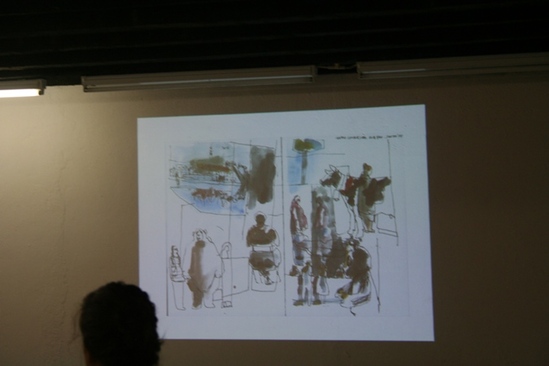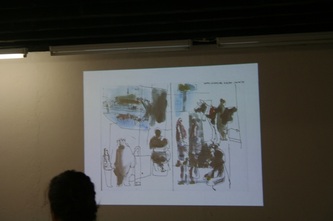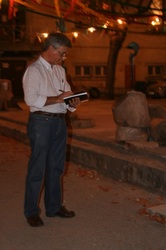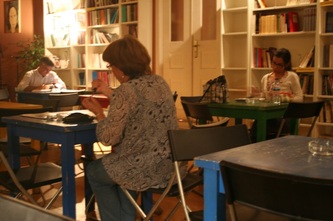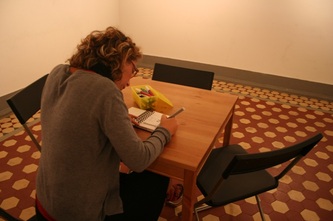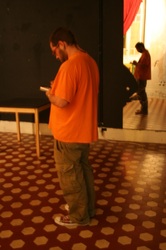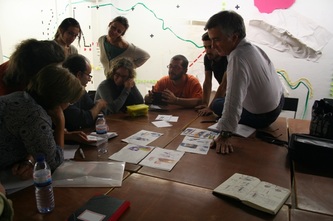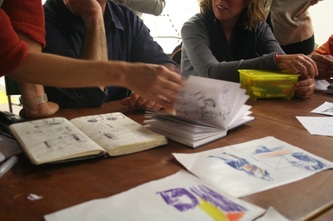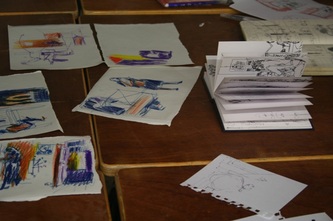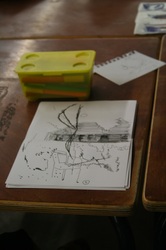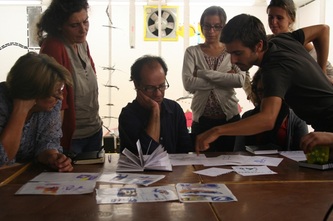_© All rigths reserved to Associação Espaços do
Desenho-Drawing Spaces. Text.Sound.Video.Images
_
drawing narratives
WORKSHOP Developed as PART OF A SERIES OF WORKSHOPS
UNDER THE THEME “8 POSSIBILITIES OF MAKING DRAWING”
Drawing Spaces, Lisbon, Portugal
22 SEPTEMBER 2011
WORKSHOP Developed as PART OF A SERIES OF WORKSHOPS
UNDER THE THEME “8 POSSIBILITIES OF MAKING DRAWING”
Drawing Spaces, Lisbon, Portugal
22 SEPTEMBER 2011
REPORT 12 -
IDEAL
Intercultural Drawing for European Adult Learning
Intercultural Drawing for European Adult Learning
WHAT
This workshop aimed to stimulate the use of graphic diaries to produce experimental drawings using the graphic diary as a personal study tool. The aim was also to remove any expectation of producing final artistic drawings, but rather to provide oneself with the opportunity of experimenting different ways of making drawing and by turning the page, to be able to engage with a new or progressive stage of the study. Drawing Narratives aimed at engaging participant in drawing through several strategies to experiment with sequential drawing and analytical diagrams.
WHERE
Drawing Spaces, Fábrica de Braço de Prata, Lisbon, Portugal.
WHEN
22 September 2011, 19h00-23h00
WHO
Facilitators and Staff
José Louro
Eduardo Salavis
Teresa Carneiro
ADULT LEARNERS
9 Female and Male adult participants, with an age range between 25 and 56 years old.
(This workshop was open to anyone)
WHY
This workshop was part of a project which aimed to respond to the dynamics of Drawing Spaces by presenting a series of public workshops coordinated by a variety of experts in the field of drawing. These workshops took place over a period of 2 weeks, during opening hours – from Wednesday to Saturday, from 19h to 23h – following the ‘open residency’ model. This gave the public the opportunity to daily visit and accompany the development of these experimental sessions around drawing.
These series of workshops were designed to extend the public contact with artists and with the specificity of the artist’s modes of working in their personal projects. The artists were asked to develop a workshop that maximized the interaction with the public; it was proposed to the public to participate in more than one of the workshops and to observe the diversity of the artists’ approaches. Drawing Narratives aimed at engaging participant in drawing through several strategies to experiment with sequential drawing and analytical diagrams.
HOW
This session was used to explore the graphic diary as a tool to recognize the urban space and its surroundings: participants were therefore given several strategies to experiment with sequential drawing and analytical diagrams. After an introduction by José Louro, the artist invited to propose the working methods for this workshop, the participants were asked to develop a series of drawings throughout the several spaces of Fábrica Braço de Prata.
VALUE FOR LEARNERS
Graphic dairies have the advantage of being an uncompromised and continuous way of maintaining a relationship with drawing practice. Participants learned also the advantage of starting a fresh drawing every time a new page was turned, giving them the possibility of being consistent with methods and techniques in the study of a subject. The theme proposed for the workshop was also quite important as participants were encouraged to relate their own bodies to the narratives that they were constructing. In this way, they became more conscious about how much they these sequence of drawings told a narrative about their ways of moving their bodies, circulating in space and looking and relating to things in their environment.
Very simply, participants learned the way that drawing can be used to tell a story or an idea, and how autobiographic this way of drawing can be. The annotation aspect drawing was extremely well perceived by the participants.
VALUE FOR THE FACILITATORS
Facilitators learned that the involvement of the participants in the workshop activities extended the reach of the project and helped create a word-of-mouth effect where learning and doing became a shared experience between facilitators and participants. The fact that facilitators were also drawing and engaging in the proposed working methods created an environment where everyone felt their contribution was relevant while adding value to the project. Facilitators also understood that by consciously involving participants in social environments made participants aware that they were telling stories about their own relations to the environments. This was of great value for facilitators as one of the main ambitions of the project was to make participants aware that narrative drawing can be about telling a story of others as much as it can be about telling a story about the one who draws.
VISUAL RECORDS
This workshop aimed to stimulate the use of graphic diaries to produce experimental drawings using the graphic diary as a personal study tool. The aim was also to remove any expectation of producing final artistic drawings, but rather to provide oneself with the opportunity of experimenting different ways of making drawing and by turning the page, to be able to engage with a new or progressive stage of the study. Drawing Narratives aimed at engaging participant in drawing through several strategies to experiment with sequential drawing and analytical diagrams.
WHERE
Drawing Spaces, Fábrica de Braço de Prata, Lisbon, Portugal.
WHEN
22 September 2011, 19h00-23h00
WHO
Facilitators and Staff
José Louro
Eduardo Salavis
Teresa Carneiro
ADULT LEARNERS
9 Female and Male adult participants, with an age range between 25 and 56 years old.
(This workshop was open to anyone)
WHY
This workshop was part of a project which aimed to respond to the dynamics of Drawing Spaces by presenting a series of public workshops coordinated by a variety of experts in the field of drawing. These workshops took place over a period of 2 weeks, during opening hours – from Wednesday to Saturday, from 19h to 23h – following the ‘open residency’ model. This gave the public the opportunity to daily visit and accompany the development of these experimental sessions around drawing.
These series of workshops were designed to extend the public contact with artists and with the specificity of the artist’s modes of working in their personal projects. The artists were asked to develop a workshop that maximized the interaction with the public; it was proposed to the public to participate in more than one of the workshops and to observe the diversity of the artists’ approaches. Drawing Narratives aimed at engaging participant in drawing through several strategies to experiment with sequential drawing and analytical diagrams.
HOW
This session was used to explore the graphic diary as a tool to recognize the urban space and its surroundings: participants were therefore given several strategies to experiment with sequential drawing and analytical diagrams. After an introduction by José Louro, the artist invited to propose the working methods for this workshop, the participants were asked to develop a series of drawings throughout the several spaces of Fábrica Braço de Prata.
- First of all, facilitators and participants gathered in a room at Drawing Spaces. A presentation was made where José Louro showed a number of graphic diaries that the artist had produced as his own practice.
- José Louro then presented a powerpoint presentation, showing a series of his own works introducing the drawing activity as a way of producing narratives. The artist explained different methods for producing sequential drawings, such as registering a path where different elements were drawn as they were being observed from different perspectives, or registering the movement of the eyes and head as they turned around in the same space and position, while looking and registering things in a panoramic perspective. José Louro also talked about the use of analytical diagrams in narrative drawing by showing works of other artists, zooming it and out as another possibility of producing narrative drawings, and the importance of the consistency of drawing material in this way of drawing.
- Participants were then asked to create a path in the surrounding area of Fábrica Braço de Prata and draw a sequence of drawings where they would chose what to draw from their starting point, after making this drawing they would advance to point which they had drawn and chose another limit for their drawing, and after this advance to the point they had drawn and chose another one to draw. And so forth.
- For the second part of the workshop, participants were asked to produce a sequence of drawings inside any space at Fábrica Braço the Prata. They could choose either to draw a new path, using the same method as the one used on the previous exercise, or to chose a spot and move their head and eyes, while drawing a panoramic series of drawings.
- For this second part of the project participants were also asked to experiment zooming in and out as a way of creating different dynamics in their sequences of drawings.
- Participants were asked to produce drawings using directly different sized brushes to capture elements for their narrative drawings, while alternating with drawings produced with pencils, pens and ink. The purpose of this was also to enable participants to create different dynamics in their narrative sequences.
- Facilitators also drew throughout this workshop. Participants and facilitators exchanged views on techniques and methods as the workshop developed.
- At the end of the workshop participants and facilitators gathered informally around the tables at Drawing Spaces. Everyone presented the sequences of drawings they had produced throughout the session. This was a very good way of engaging both participants and facilitators on a final discussion about processes, techniques, methods and results.
VALUE FOR LEARNERS
Graphic dairies have the advantage of being an uncompromised and continuous way of maintaining a relationship with drawing practice. Participants learned also the advantage of starting a fresh drawing every time a new page was turned, giving them the possibility of being consistent with methods and techniques in the study of a subject. The theme proposed for the workshop was also quite important as participants were encouraged to relate their own bodies to the narratives that they were constructing. In this way, they became more conscious about how much they these sequence of drawings told a narrative about their ways of moving their bodies, circulating in space and looking and relating to things in their environment.
Very simply, participants learned the way that drawing can be used to tell a story or an idea, and how autobiographic this way of drawing can be. The annotation aspect drawing was extremely well perceived by the participants.
VALUE FOR THE FACILITATORS
Facilitators learned that the involvement of the participants in the workshop activities extended the reach of the project and helped create a word-of-mouth effect where learning and doing became a shared experience between facilitators and participants. The fact that facilitators were also drawing and engaging in the proposed working methods created an environment where everyone felt their contribution was relevant while adding value to the project. Facilitators also understood that by consciously involving participants in social environments made participants aware that they were telling stories about their own relations to the environments. This was of great value for facilitators as one of the main ambitions of the project was to make participants aware that narrative drawing can be about telling a story of others as much as it can be about telling a story about the one who draws.
VISUAL RECORDS
